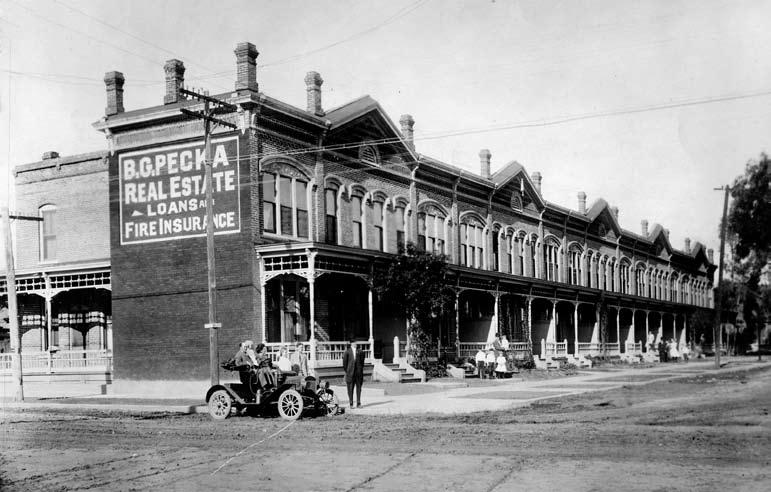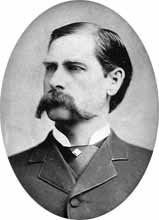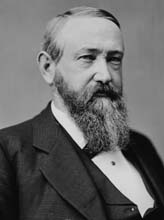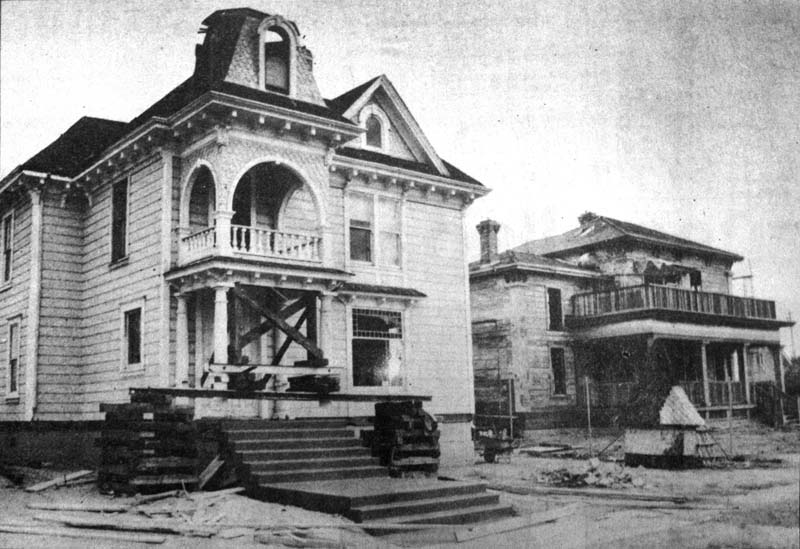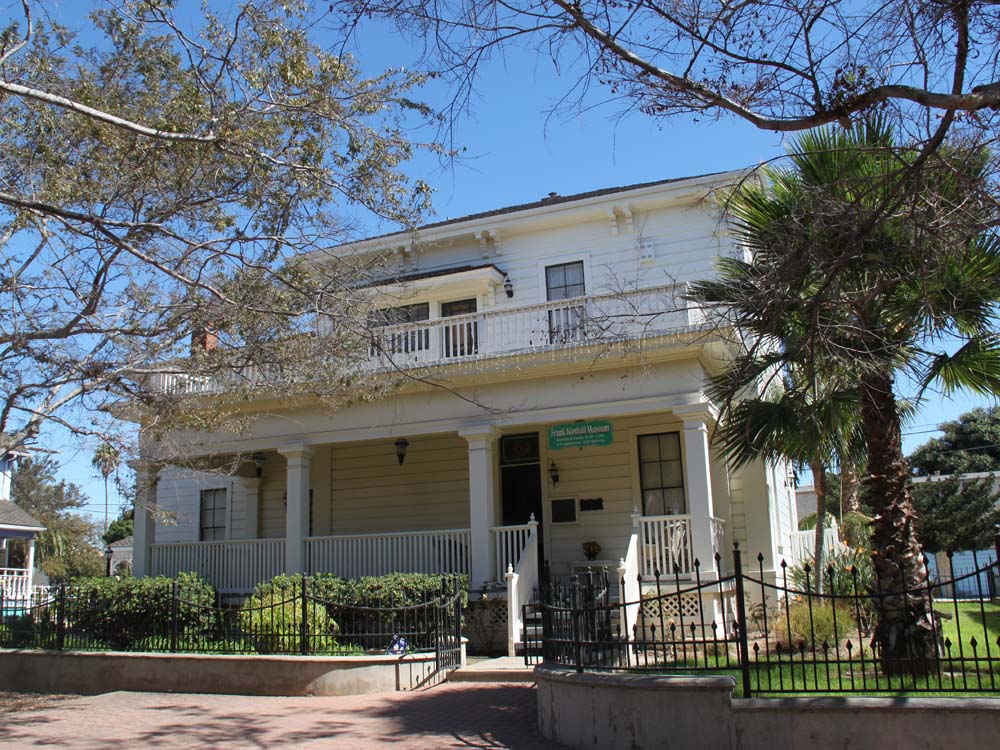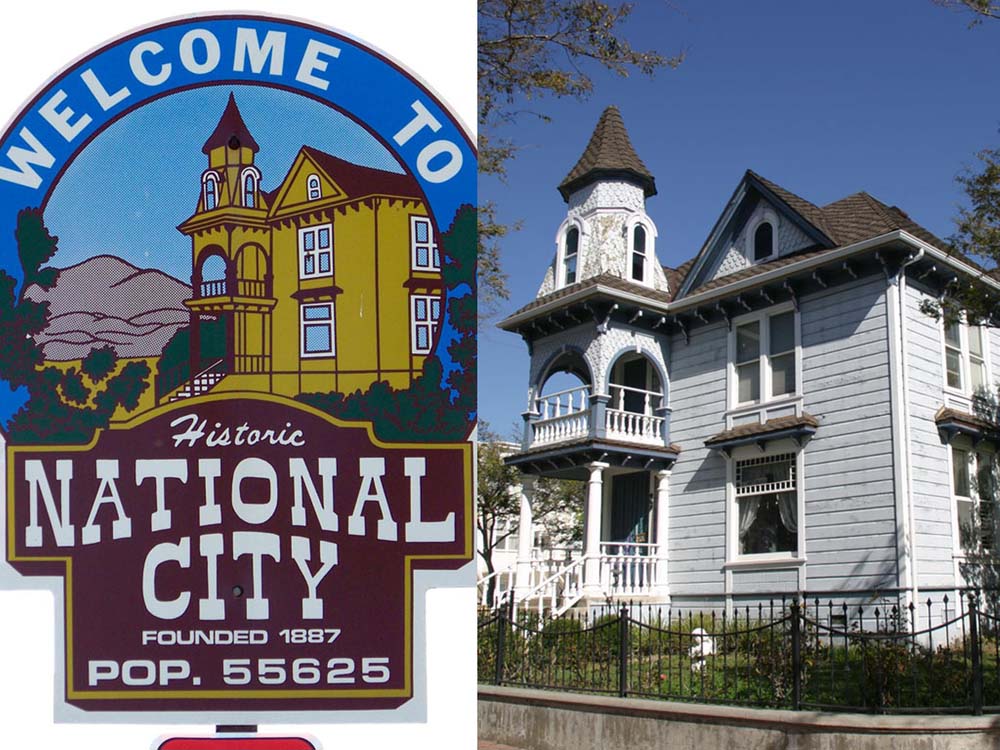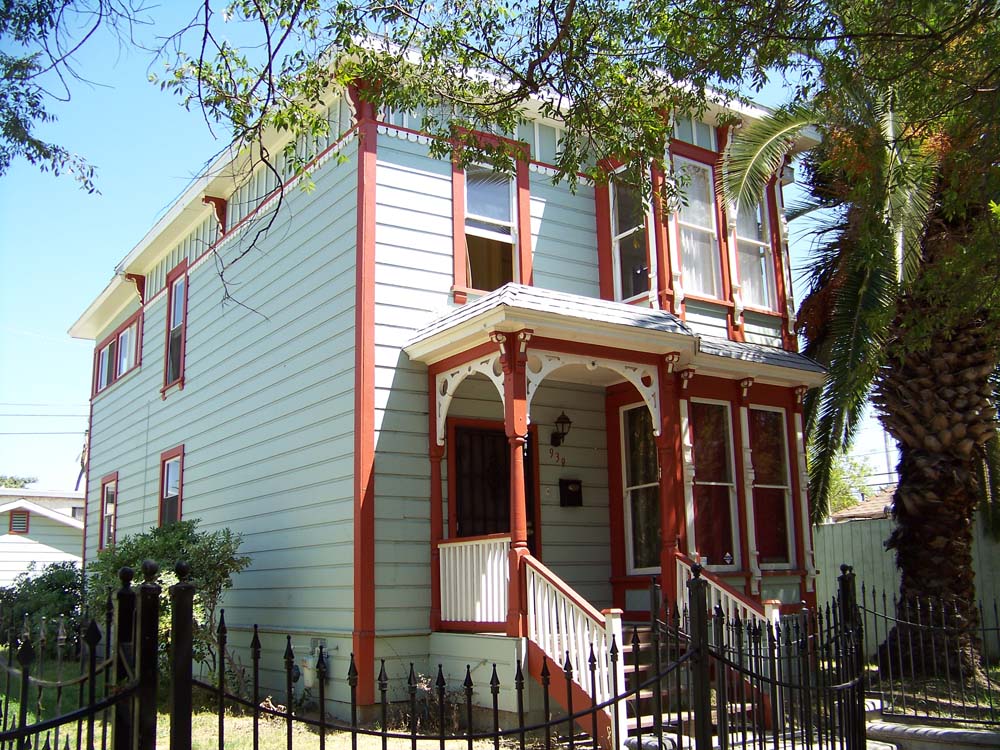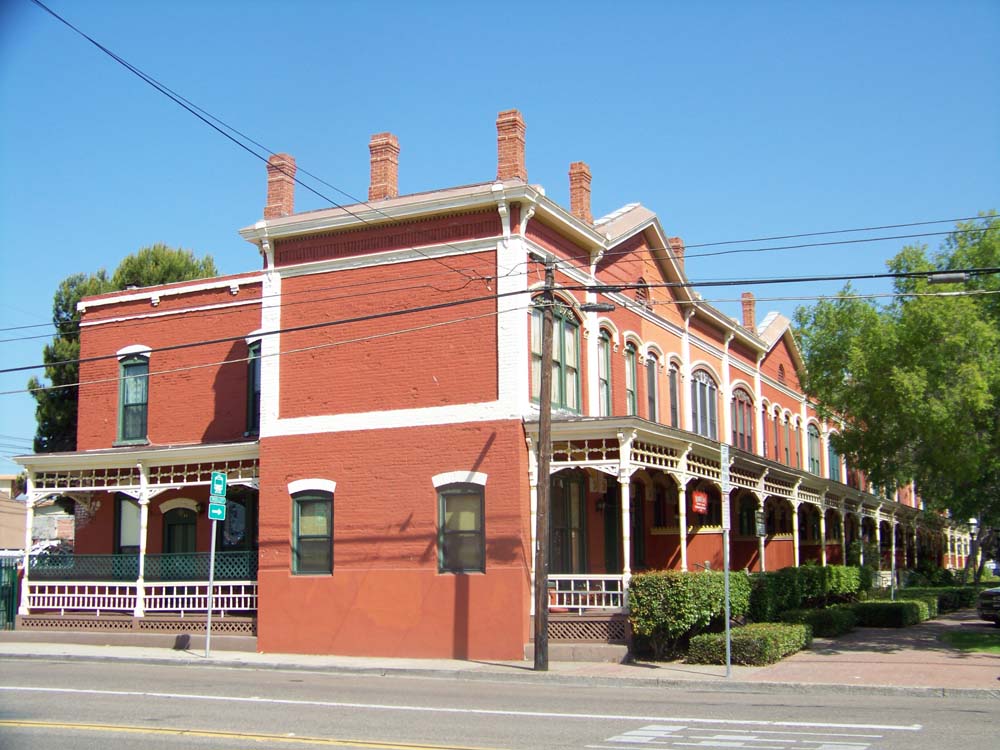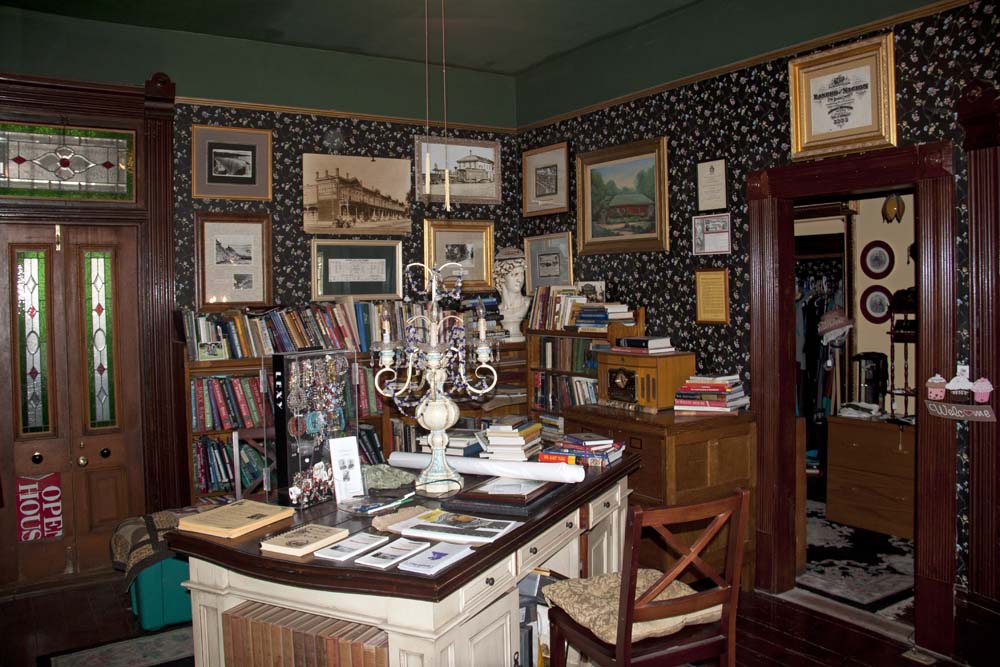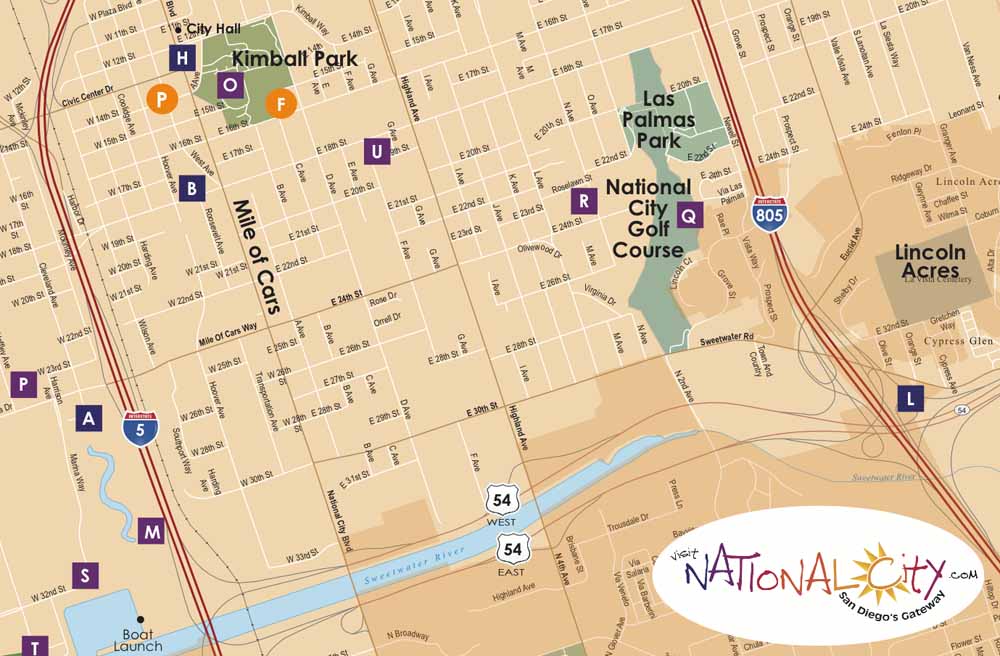|
National City Heritage Square and Brick Row
Brick Row in 1911
1887/06/09 - Frank Kimball built Brick Row in 1887. According to the National City Record June 9th, 1887, "Several hundred houses are badly needed to rent and we learn that capitalists are figuring on the same. Mr. Kimball is to be commended as a pioneer in the tenement housing movement." Leslie Trook described it as "the only structure of its type on the West Coast. Designed by architect R.C. Ball in the style of Philadelphia row houses (constructed so that each home in the row of homes shared common walls with its neighbors), 10 homes were built on the west side of A Avenue, between 9th and 10th Streets. The building of the houses was negotiated with the superintendent of the railroad. According to a record in Kimball's diary, "there was a 10-year contract the two end houses to be rented for $50 a month the rest for $40." When Mr. Kimball was ready to turn over the houses, the superintendent sent the papers East to be signed at the head office. Word came back that the superintendent had "exceeded his authority." Kimball then retained both the title and the cost of the houses. A September 20,1887, diary entry read, "Two men went to work this morning on my ten houses ... 250 ft by 45 ft: J.J. Hunt was the contractor and was initially paid $22,000 for his work. A September 16, 1896, diary entry read, "Brick Row-$34,000." Brick Row was built with over 240,000 bricks, many of which were made from the Kimball's brick kiln. All the wood used in the construction was redwood. Each unit is a self-contained, two-story structure with wooden floors, cast iron fireplaces, four bedrooms upstairs, a kitchen, parlor, formal dining room, and butler's pantry. Still at its original location, and with each unit owned by individual tenants, Brick Row, a National Register Landmark, makes up part of Heritage Square, which was dedicated on October 25, 1980." ( Trook, National City, Kimball's Dream, 1992, p. 37. )
1889 - One of the early residents of Brick Row was Wyatt Earp. He stayed in National City when he was involved in prize fights and gambling in Tijuana. According to Richard Pourade, "One of the enterprising operators of gambling places was Wyatt Earp, the famed marshall of the Western plains. He was undergoing some legal embarrassment at the time, having been indicted for murder in Arizona in the shooting of the men who had slain his brother. He had fled to El Paso, Texas, and attracted by the reports of the boom sweeping Southern California, had come to San Diego, where with his wife he invested in business and speculative property and opened three gambling halls. One was on Fourth Street between Broadway and E Street and fronting on Horton's Plaza; another in the 800 block on Sixth Street, next to the Hotel St. James; and the third on the north side of E Street, near Sixth. He conducted twenty-one different games of faro, blackjack, poker, keno, and other lesser known games of chance. Little mention of him is to be found in contemporary newspaper files, perhaps out of respect to his difficulties with the law. The San Diego city directory of 1888-89 lists him as "capitalist." He refereed a prize fight which was the feature of a day-long Sunday fiesta, with cockfights, bullfights and a lassoing contest across the border below the town of Tia Juana." ( Pourade, The Glory Years, 1964. )
1891/04/23 - Frank Kimball wrote in his letters that President Benjamin Harrison stopped in National City and visited the Kimball home where Frank gave the president an Otay watch. Harrison's western tour in 1891 was, at that time, the longest journey ever undertaken by any President while in office. The 9,232 mile rail trip lasted one month and three days. The trip was partly planned and largely financed by the former Governor of California, Leland Stanford. The pioneer railroad builder had invited the President to his ranch in Palo Alto to discuss a professorship at the newly built Stanford University and to participate in the dedication of that institution. When President Harrison came to San Diego on April 23, 1891, the San Diego Union reported: "Since the news first came that the nation's chief executive would confer upon this people the unusual honor of a visit, the leading men and women of San Diego have wasted no time in getting ready to receive their expected guest in fitting style. As a result the city today is decked out in a holiday attire of the national colors; the wall of her principal buildings ar hidden behind masses of gay-hued bunting, and every flag is flying triumphantly from the very top of its staff. The Presidential train will arrive at the depot at 6:30 in the morning. President Harrison will not alight from his special train on his arrival in the city this morning but will be carried on through National City, around the peninsula and directly to the Coronado hotel, where he will have breakfast." (Irene Phillips, "Diaries of Frank A. Kimball, California Pioneer, Excerpts and Comments.") 1971/09/05 - Efforts to preserve Brick Row began in the early 1970s: "Malcolm C. Greschler may be a newcomer to National City but he already has begun to fight to preserve its heritage. Gerschler moved here in January to become the city's planning director. He suggests that a "Heritage Square" be established in the heart of this community as a showcase of National City's history and a tourist attraction "something like San Diego's Old Town." Gerschler has recommended that A Street be closed to traffic from Eighth Street to the Civic Center and redeveloped as an 1880-styIe "Main Street." "My mental picture of National City in the 1880's is of a little patch of the Middle West transplanted to the southwest corner of the nation where the Mexican Spanish motif was predominant," Gerschler said. "With this came the gingerbread architecture, landscaping, life styles and customs of Middle West America. How distinctly different this must have seemed to San Diegans at the time. "I think that, this flavor is what deserves preservation." he said. "The National City General Plan lists 66 historical sites. It is probably quite impossible to preserve and-or restore more than a very few of the 66 sites so it becomes more important to have a priority list. Several of the 66 sites already have been plowed under. "As an observation, the list of historical sites seems to ignore Frank Kimball's overwhelming interest in making National City the western terminus of the (now) Santa Fe Railway," said Gerschler, who is a self-confessed railway history buff. "His California Southern Railroad is loaded with rich historic value, to say nothing of the National City and Otay Railroad. 'The Kimball Block ‹ Brick Row on A Street ‹could be restored and converted into some specialty shops. The upper floor could be developed into a hotel with furnishings from the 1880's," he said. Brick Row stretches from 9th to 10th streets. When Kimball announced in the fall of 1887 that he was going to build a 10-dwelIing; two-story building on the site, National City residents felt the stirrings that accompany the birth of a metropolis, Gerschler noted. The building was needed to meet the growing demands for housing space that accompanied the news that National City was going to boom as a railroad town. The dream was blown away when rail developers decided instead on the Los Angeles area as a terminus. "But this street, now, could be complemented with a railroad exhibit and depot, museum. Granger Music Hall, a few select examples of period housing, gardens, cafes, gas lights and a small chapel for weddings," Gerschler said. "Motels, restaurants, offices a n d stores would be entirely appropriate if kept in architectural accord with the theme." ( The San Diego Union, Sept. 5, 1971 )
The Kimball house and the Elizur Steele house under renovation after being moved to Heritage Square
1973 - The first home to be moved to Heritage Square was the Kimball house. "In the year of Frank Kimball's death, the home that Kimball had built was purchased by Charles L. Welshbacher. It changed ownership a number of times during those years and as a consequence fell into disrepair, threatening to be demolished in 1973. Through the efforts of Mayor Morgan and the city council, the home was obtained by the city. The process of restoration took two years. David Sheldon, Assistant Director of Rehabilitation and Home Improvement for the city, supervised the project, which at times was difficult to watch, especially when the front porch of the Kimball home caved in and a finely sculpted piece of wood was destroyed. It was a multi-million dollar federally funded project, the Center City Redevelopment Project, that allocated funds for historical restoration. The city created an architectural plan for a Heritage Square at A Avenue, where Brick Row stood at its original 1888 site. ( Trook, National City, Kimball's Dream, 1992, p. 91. ) 1974/09/25 - "City officials are backing a concerted effort to move and save the 105-year-old Kimball House. Chief building inspector N.S. Biggs said he has had the three-story building at 21 W. Plaza Blvd. checked by electrical experts, a private moving contractor and a fire marshal. "We hope to have a report ready for the City Council by next Tuesday," he said. "The building is in very poor structural condition and the people who have looked it over so far have expressed grave doubts that the building could stand the move." The City Council has committed itself to trying to save the frame building that was built in 1869 by Frank Kimball, the railroad magnate who founded National City. Parking Lot Planned It has to be moved or destroyed to make room for a parking lot that is needed by Thomas H. Cosby Jr. Post, Veterans of Foreign Wars, which owns the property. The Chamber of Commerce has suggested to the City Council that the house, visited by President Benjamin Harrison and his party April 30,1891, be moved onto Kimball Park behind the Boys' Club and be renovated into a museum to house other pioneer memorabilia. The City Council thinks it should become part of the proposed Heritage Square being considered for the four-block area centered around the Brick Row at A Avenue and Plaza Boulevard. The council agreed unanimously that this area should be developed into the South Bay's own "old town." Planning Director Malcolm C. Gerschler, one of the earliest and strongest proponents of the Brick Row plan, said this area is attractive to those people thinking of moving the Kimball House because it is so close. Close Distance A Factor "The Kimball House is only a block and a half away from this area and that makes it much easier than having to move it any great distance," Gerschler said. He said his department is seeking ways of financing preliminary planning of the Heritage Square concept. Brick Row is a block long series of tenement buildings stretching along A Avenue from 9th Street to Plaza. Kimball built these dwellings in the late 1880s to meet the growing demand for housing space that accompanied news that National City was to become the southwestern terminal of the national railroad network. This dream faded when rail developers and politicians. decided on Los Angeles as the western terminus of the Santa Fe Railway". ( The San Diego Union, Sept. 25, 1974 )
The Kimball house was moved to Heritage Square in 1975 and has become the Kimball Museum operated by the National City Historical Society
1976 - In addition to the Kimball house, "two more historical homes, both constructed in a Victorian architectural style common in the East, were moved onto that location. The Rice-Proctor Home was the home of Julius Rice, an educator and real estate broker who bought the land in 1887 from the San Diego Land and Town Company and sold it to John W. Proctor in 1897. The third structure, the Steele-Blossom House, was built in 1879 by Elizur Steele, a well-known builder in early National City. He was a partner with Elijah Valentine, a real estate agent for the Kimball brothers G.E. Blossom, a National City grocer, and his family were the first occupants. Subsequent owners were Frederick Crandall, a realtor and City Trustee, who came to San Diego from Illinois, and Florence Ennis." ( Trook, National City, Kimball's Dream, 1992, p. 91. )
The Steele house is the image used by the city of National City for its welcome sign. Elizur Steele came to National City in 1874 and became a real estate agent for the Kimball Brothers. He developed many homes and properties in National city and donated the land for St. Matthews Church. In 1887 he built the Steele building at National Avenue and Eighth Street, a three-story edifice made from the same brick kiln that Kimball had built to construct Brick Row. His elaborate Victorian home was constructed in 1879 at 904 East 8th Street and was called "El Cipres" (the cypress). It was built of redwood, had 12 rooms and a shingled third-floor tower. When the house was moved to Heritage Square in December 1877, along came a stone cistern from the original property. In 1883 he sold the house to Charles F. Blossom, and in the 1920s was owned by Frederick Crandall. After Crandall died, it was owned by Florence Ennis. (Martinelli, Heritage Square, 2014).
Julius Rice came to National City from Vermont in 1883 with his wife, Laura Steele, daughter of developer John Steele. Their daughter Lilian became a noted architect. Julius was a teacher and school principal and member of the school board and in 1900 was deputy county superintendent of schools. He was elected to the first board trustees when National City was incorporated in 1887. He also sold real estate and owned fruit orchards. His home at 740 East Second Street was built in 1887. City directories list Julius Rice as a rancher in 1904 and as a real estate agent through 1913. ( Carnes, Early National City, 2008, p. 38. )
1977/12/29 - "Heritage Square is taking shape. The project on A Ave. between 9th St. and Plaza Blvd. began several years ago when historical preservation was added to National City's notion of redevelopment. The 1974 federal law that provided funds for community development through five years of grants emphasized history and housing production and rehabilitation. Almost all of these things are happening in Heritage Square. Workmen are swarming over Kimball House, the 109-year-old home of city founder Frank Kimball. It was moved to A Ave. early this year, and it will be used as a community showplace and as a meeting center. Caretakers, possibly an elderly couple, will live upstairs. Nineteenth century touches are being added, along with more modern additions like a garage in the rear. The big dining room will be furnished in the style of the late 1800s, and one room filled with the bedroom set that Kimball's brother Warren once' used. Officials found the furniture in a Chula Vista garage, Next door at Crandall-Steele-Ennis house, Kimball's Victorian neighbor, workmen this week added front steps and readied the foundation for a rear addition of two bathrooms. Redevelopment officials say the three-bedroom house will be sold in February to a private party, who will finish renovations. Across the street in Brick Row, Kimball's idea of condominiums, workmen have torn down a row of offices and stores on the north end and are preparing to return the north unit‹ previously a real estate office and apartments ‹ to single family status. Additions have been torn away to reveal original facades and exterior woodwork. A Chula Vista man has purchased two other units, one damaged this summer by a firebomb, and is interested in taking out city low interest loans to fix them up. Another owner, angry at the city because officials want him to remove a deteriorated garage, has posted a "for sale" sign. Redevelopment officials have not been welcomed by many owners in the block-long building. City overtures aimed at helping the owners fix up Brick Row units were rebuffed and the city eventually backed off. Officials hope a gradual process of attrition will eventually attract owners interested in becoming a part of Heritage Square. The dream is to turn that one-block section of A Ave. into a haven place for pedestrians and sight-seers. The road will be narrowed and a slight curve will be built in. Then Heritage Square, will be finished. ( The Imperial Beach Star-News, Dec. 29, 1977 ) 1980/10/25 - Eight years after it was saved from demolition, the Frank A Kimball House was dedicated. October 25, 1980 marked the official opening of Heritage Square as a symbol of the city's devotion to the preservation of its early history." ( Trook, National City, Kimball's Dream, 1992, p. 91. )
Brick Row as pictured in the 1987 Centennial Edition of the Star-News.
1981/10/15 - "Completion of renovation of the 10-unit, two-story Brick Row in National City will be celebrated today at Heritage Square at Ninth Street and Plaza Boulevard. City Councilman J. Louis Camacho says he frequently drives by the 900 block along A Avenue in National City to reminisce about his boyhood. On the west side of the street is where Camacho, 60, was born. It is a 19th-century landmark, a two-story, 10-unit brick row house which Camacho calls "California's first condominiums." When he was growing up there during the 1930s "nobody had the desire to restore the homes," he said. "Now it's a unique little center of nostalgia." Today, at 11 a.m., a ceremony will be held to celebrate the completion of the exterior refurbishing of the house, or houses, known as Brick Row. With the project finished, the city's efforts to restore the entire area, known as Heritage Square, also is complete. People still live in the two-story, 10-unit Brick Row. The historical centerpiece, which is on the National Register of Historic Places, sits across the street from three, powder-blue, Victorian-style houses imported from other locations in the city. Both sides of A Avenue, between Ninth Street and Plaza Boulevard, have been designated Heritage Square. Restoration of Heritage Square took five years and cost $1 million. The intent of the massive project was to restore the houses to their original appearance of the late 1800s, when they were modeled after the Philadelphia row-housing style, with individual units separated only by a thick brick wall, said David L. Sheldon, assistant director of rehabilitation for the Community Development Commission. Camacho, 60, grew up in the northern section of Brick Row, which was constructed in 1867 for $2,200 by Frank A. Kimball, founder of National City and, at the time, a prominent financier. Specifications were obtained by Kimball from Philadelphia, where the row-house scheme contrasted with the Victorian residences typical in Southern California at the time, Sheldon said. The home was used to entertain railroad magnates of the Santa Fe Railroad, and politicians, including President Benjamin Harrison. The three Victorian-style homes moved to Heritage Square by the city include the Frank Kimball house, originally owned by Kimball. It is now a museum open on weekends. The Elizur Steele-Crandall-Ennis House, built in 1879 and used for offices, and the Proctor House complete the makeup of Heritage Square. The houses are fronted by cobblestones, hitchposts and gaslamp-style lights." ( The San Diego Union, Oct. 15, 1981 ) 1983/02/23 - "The house that Frank Kimball built in 1868 had been home to dozens of families when, in 1973, it looked as if it would be demolished to make room for a parking lot. Kimball, a businessman who dabbled successfully in land development, was one of the founders of National City. His house, a 15-room ranch house, was one of the first residences in the infant community, and it was large enough for Kimball to comfortably entertain other prominent citizens, including at least one U.S. president. In 1973, as a Veterans of Foreign Wars post made plans to demolish the house at Plaza Boulevard, the city of National City, led by Kile Morgan, came up with an idea to rescue the dilapidated landmark. After some negotiations, the city bought the house from the VFW. and in 1977, the building was loaded onto a very large trailer and trucked about a block and a half away to what is now National City's Heritage Square. The square sits like a small Victorian gem in a city whose reputation for inelegant architecture was established years ago by runaway, unplanned development On one side of the square sits a row house patterned after the Philadelphia-style brick house popular in the 19th century. Kimball conceived and financed the row house, now called Brick Row. and it sits today in the same spot it sat when it was built in 1888. Across from Brick Row sits the Kimball House, flanked on either side by the Rice-Proctor House and the Elizur Steele-Crandall-Ennis House, both built in the late 1800s. The Rice-Proctor House had to be moved to Heritage Square from National City's Roosevelt Avenue. The Etizur Steele-Crandall-Ennis House was already located at Heritage Square. After moving the Kimball House to the square, the city gutted the inside of the house, rebuilt it to duplicate a Victorian-era house, and then opened it to public view. The city also turned the upstairs servants quarters into a modern apartment. Since 1979, Ken and Terry Jacques have lived in the apartment as caretakers and tour guides for the house. The Jacques met while they were working on a history project as students at the University of San Diego. Terry eventually earned a master's degree in history. When the couple beard that National City was looking for live-in caretakers for the historic Kimball home, they applied for the job. In exchange for the cozy upstairs apartment, they open the house to visitors 14 hours each week, take care of the yard, help with some of the refurbishment of the house, and ward off vandals. At times, the number of visitors in a single tour has reached 180. Once, a man who lived in the house around 1907 dropped in with photos of the house as it was when be was a child Kimball, if he were to see his house today, probably wouldn't recognize it. In the 1920s, long after he had left his house, the new owners knocked down the walls of some upstairs and downstairs rooms to make way for the long porch and balcony that sit at the front of the house today. Kimball moved out of the house in 1897 because his fortune had been lost and his mortgage was being foreclosed. After that, the house changed hands several times over the years. In the late 1950s, the constant change in ownership started showing, as the house began to deteriorate from a lack of attention. By the time it was moved by the city to Heritage Square, very little of the interior remained as it had been during Kimball's life. The curved bannister that he bad bought in San Francisco still led up the long staircase just inside the front door of the house, and the built-in cabinets in the dining room were still intact. But the original wallpaper and paint, and even parts of the interior walls themselves, were gone, giving tee city little to go by in choosing new decorative items. The interior decorator the city hired to do the house, Loretta Hyatt, had to work from scratch. Most of the current furnishings in the house were bought by the decorator at antique and estate sales in San Francisco. The exception is the bedroom furniture in a room upstairs. That furniture belonged to Kimball and was donated to the city by some of his relatives who had been storing the pieces in their garage. When the city moved the house, the two original fireplaces downstairs crumbled en route. Luckily, two other Victorian-era fireplaces were able to be salvaged from an old house in San Diego that was being demolished. Unlike the Villa Montezuma ‹ the refurbished Victorian house in San Diego now owned by the San Diego Historical Society ‹ Kimball's house doesn't have any fancy curving towers. In 1868, there was no planing mill in National City to produce the special wood for such architecture, so Kimball had to settle for simple square corners on his house. Relying in part on block grants, the city of National City spent about $325,000 to move the house, rebuild its interior, refurbish its exterior, and landscape the square. In 1868, Kimball and his brothers had bought the 26,631 acres that surrounded his house for about $30,000. The houses neighboring the Kimball House in Heritage Square are privately owned and closed to public tours. However, the Kimball House is open to visitors Wednesday and Thursday evenings, 5 to 8 O'clock, and Sundays from 10 am. to 4 pan. The square is located on the 900 block of A Avenue in National City. ( The San Diego Union, Feb. 23, 1983 )
Brick Row today
1987 - "City and community officials, baring one brush, applied the last coat of paint to Brick Row in a ceremony this week marking completion of the beautification project and Heritage Square. The 190,000 exterior improvement project was a joint effort of the City, the city Community Development Commission and owners of the 10-unit Brick Row which occupies the west side of A Ave. in Heritage Square, Plaza Blvd. to 9th St., In National City. Frank Kimball, one of the founders of National City, let a contract to build Brick Row ln September 1887. It was a two story, 10 unit building that cost $2.200. The building was patterned after those Frank Kimball was familiar with in Philadelphia from his trips there for negotiations to bring the railroad to National City. It was to house Santa Fe Railroad VIPs because housing was so scare here. There are 240,000 bricks in the building, many from the Kimball kiln built In 1886. Bricks that time were $8 a thousand, according to a report given by Arnold Peterson, Community Development director, at the ceremony. The 10 flights of stairs were built for $625 under a separate contract, Peterson said, "We have tied the past, present and future together in this improvement of Brick Row. This is also the completion of Heritage Square which includes Brick Row, the Frank A. Kimball House, the Elizure Steele-Crandall-Ennis House, the Proctor House and the Victorian Street scene." Dave Sheldon, assistant director of Community Development, said, "We rebuilt the front facade and some of the owners took out low interest loans the commission had available to refurbish the interiors." Brick Row was for many years the prestigious place to live in National City, and its present owners still think so. It is listed in the National Register of Historic Places. The Community Development Commission has invested some $1 million in block grant funds in Heritage Square. Brick Row is on its orlginal site, but the other houses have been resettled there. The ceremony had a special significance to Councilman J. Louie Camacho. He was born in the unit at the north end of the row and spent much of his childhood there. Other dignitaries attending included Mayor Kile Morgan, Councilmen Jess Van Deventer and George Waters, Port Commissioner George Jame., City Manager Tom McCabe, former Councilman Joe Reid, Chamber manager George Webster, Tom Morrow and Barbara Strahan, chairman of the Community Development Committee, in addition to Peterson and Sheldon." ( Star-News newspaper clipping in National City Centennial Scrapbook 1887-1987 ) 1988/09/22 - Historic homes open doors to public by Alana Coons: "Next to the Frank Kimball house is the Elizur Steele house. This house was also saved from demolition. The Steele house has been rehabilitated into offices. This type of restoralion we call adaptive re-use and is a good way to both save our hemage and provide a quality environment for professionals. It is a beaullful example of Queen Anne architecture and is featured on the "Welcome to to Historic National City" signs Elizur Steele and his brothers were promment builders of the lime. They built both residential and commercial structures. The Steele business block, originally located on National Avenue but since demolished, was one of the most beautiful commercial structures in all of San Diego County. The Steele brothers and families were also great contributors to the community, making large donations of both land and money to community organizations. The tour of this house will be given by Mitchell Beauchamp, whose busIness Pacific Southwest Biological Services is located in the Steele house. Beauchamp is a third-generation National City descendant. The house will also soon boast of an authentic color scheme on its exterior, so this is one you'll want to keep your eyes on after the tour." ( Star-News newspaper clipping in National City Centennial Scrapbook 1887-1987 )
The National City Historical Archive Room in Brick Row
2013/04/30 - "A preserved area in National City known as Heritage Square recently gained a new addition. The Historical Archive Room packed with rich memorabilia from the 1880s is now open to the public. The archive room is about 800 square feet, chock full of ancient newspapers, photos, records and recipes from the 1880s. Located on the bottom floor an old home on Brick Row, the archive room commemorates National City's heritage. "I love it," said Janice Martinelli, curator of the Frank Kimball Museum, also part of Brick Row. "I can't imagine doing anything else." Martinelli, who is also the president of the National City Historical Society, said preserving history is about educating the youth of the future. In addition, sales are made through handmade hats, etiquette classes and events like birthday parties. Every Saturday and Sunday from 11 a.m. to 1 p.m., Martinelli and society historian Margaret Puhn provide tours of the historic Brick Row. Puhn is also the executive chef for Hannah Lee's tea house. "Every weekend we're out on the porch in Victorian (dresses) and we serve tea with a three-course meal. When people come on the weekend to see the museum, now we can take them across to see the archive, too." Martinelli lived on Brick Row for 36 years where the archives are now housed. About five years ago she and Puhn began transitioning the room for the public to thumb through memorabilia. The house that Frank built that he and his wife, Sarah, lived in is now the Frank Kimball Museum, the first house in National City. National City City Manager Leslie Deese has lived on Brick Row for nearly three years. "I love being part of the historical aspect of the city," Deese said. "It's got so much character and charm." Deese said she's seen the archive room through its progression. "I love to see that history is being preserved and maintained by dedicated people for everyone to see," she said. Martinelli said her passion to educate visitors on the history of Brick Row was sparked by the Kimball's significant contributions to the community. "I've been here for 36 years trying to tell people about Kimball," Martinelli said. "He should have never been forgotten because he brought everything here." National City is home to more than 150 historic houses. About 3,000 visitors came through the Kimball Museum last year, a number Martinelli hopes to increase with the archive room. For more information on Brick Row or to set up an appointment, call (619) 962-4128." ("National City's Brick Row opens archive room," by Allison Sampite-Montecalvo, U-T San Diego, Apr. 30, 2013.)
This city map (larger version) was produced in 2013 as part of a new three-year campaign to promote tourism in National City. Historical sites such as Heritage Square and Brick Row are a prominent part of this campaign and are featured in television news stories and website videos posted on the official Visit National City web page.
SOURCES:
|
|||||||||||
|
Home •
About Us •
Next Meeting •
Latest News •
Resources •
Organizations •
Exhibits •
Bulletins
Contact
|
|||||||||||
|
This web page was created Oct. 8, 2014 by Steve Schoenherr for the South Bay Historical Society | Copyright © 2014
|
